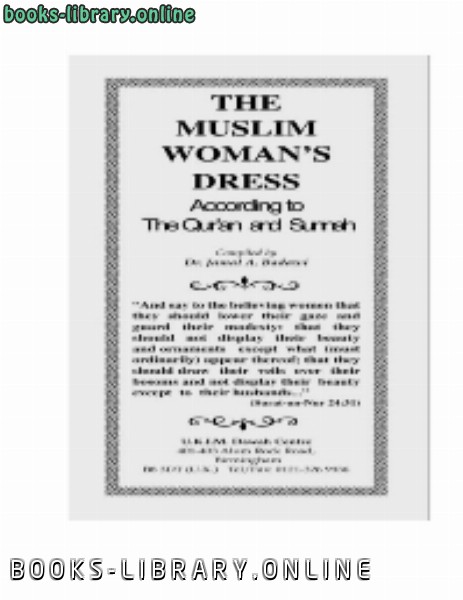📘 قراءة كتاب The Muslim Woman 039 s Dress According to The Quran and Sunnah أونلاين


Requirements in Dress
The First Requirement
Extent of Covering
The dress must cover the whole body except the areas specifically exempted. The Qur’an
states:
“Say to the believing men that they should lower their gaze and guard their modesty: that w
ill
make for greater purity for them: And Allah is well acquainted with all that they do.
And say to the believing women that they should lower their gaze and guard their modesty: that
they should not display their beauty and ornaments except what (must
ordinarily) appear
thereof; that they should draw their veils over their bosoms and not display their beauty except
to their husbands, their fathers, their husband’s fathers, their sons, their husband’s sons, their
brothers, or their brother’s sons, or the
ir women, or their slaves whom their right hand possess,
or male servants free of physical needs, or small children who have no sense of the shame of
sex; and that they should not strike their feet in order to draw attention to their hidden
ornaments. And
O you believers! Turn all toward Allah that you may attain bliss.” (Surat
-
un
-
Nur 24:30
-
31)
These ‘ayahs contain, among other things, two main injunctions:
1. A Muslim woman should not display her beauty and adornment (zeenah) except for ‘that
which m
ust ordinarily appear of it’: (ma dhahara minha), or ‘that which is apparent.’
The word zeenah lends itself to two related meanings:
a) natural or bodily beauty, and; b) acquired adornment such as a ring, bracelet’s, and
clothes.
The part of zeenah,
exempted from the above injunction, was interpreted in two ways:
a. The face and the hands. This is the interpretation of the majority of the jurists, past and
present. This interpretation is confirmed by ijma (consensus) that a Muslim woman is allow
ed
by Islam to uncover her face and hands during pilgrimage and even during the prayers, while
the rest of her body is regarded as ‘awrah (that which should be covered). This interpretation is
based on the authority of Prophet Muhammad (Allah’s blessin
gs be upon him), especially the
hadith in which he says:
“‘...If a woman reaches the age of puberty, no part of her body should be seen but this’
-
and
he pointed to his face and hands.
Whatever appears of the woman’s body owing to uncontrollable fa
ctors such as blowing of
the wind, or out of necessity such as the bracelet’s or even the outer clothes themselves.
2. The headcovers (khumur) should be drawn over the neck slits (juyoob), khumur is the plural
of the Arabic word “khimar” which means a he
adcover. Juyoob is the plural of the Arabic word
“jaiyb” (a derivative of jawb or cutting) refers to the neck slit (of the dress). This means that the
headcover should be drawn so as to cover not only the hair, but it should also be drawn over
the neck an
d be extended so as to cover the bosom.
The Second Requirement
Looseness
The dress must be loose enough so as not to describe the shape of a woman’s body. This is
consistent with the intent of the ; ’Ayahs cited above (24:30
-
31) and is surely a crucia
l aspect
of hiding zeenah. Even moderately
-
tight clothes which cover the whole body do describe the
shape of the attractive parts of the woman’s bustline, the waist, the buttocks, the back and the
thighs. If these are not part of the natural beauty or
zeenah what else is?
Prophet Muhammad (peace be upon him) once received a thick garment as a gift. He gave it to
Osamah b. Zayd, who in turn gave it to his wife. When asked by the Prophet why he did not
wear it, Osamah indicated that he gave it to his w
ife. The Prophet then said to Osamah “ask
her to use a gholalah under it (the garment) for I fear that it (the garment) may describe the size
of her bones
Book The Muslim Woman's Dress According to The Quran and Sunnah author : Jamal A. Badawi
حجم الكتاب عند التحميل : 76.2 كيلوبايت .
نوع الكتاب : pdf.
عداد القراءة:
اذا اعجبك الكتاب فضلاً اضغط على أعجبني و يمكنك تحميله من هنا:

شكرًا لمساهمتكم
شكراً لمساهمتكم معنا في الإرتقاء بمستوى المكتبة ، يمكنكم االتبليغ عن اخطاء او سوء اختيار للكتب وتصنيفها ومحتواها ، أو كتاب يُمنع نشره ، او محمي بحقوق طبع ونشر ، فضلاً قم بالتبليغ عن الكتاب المُخالف:
 قبل تحميل الكتاب ..
قبل تحميل الكتاب ..
يجب ان يتوفر لديكم برنامج تشغيل وقراءة ملفات pdf
يمكن تحميلة من هنا 'http://get.adobe.com/reader/'


 منصّة المكتبة
منصّة المكتبة 